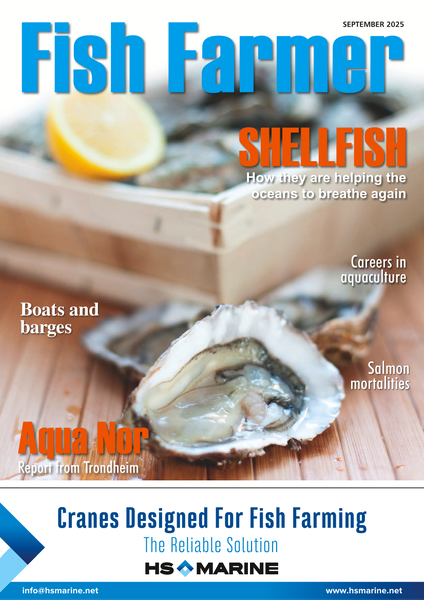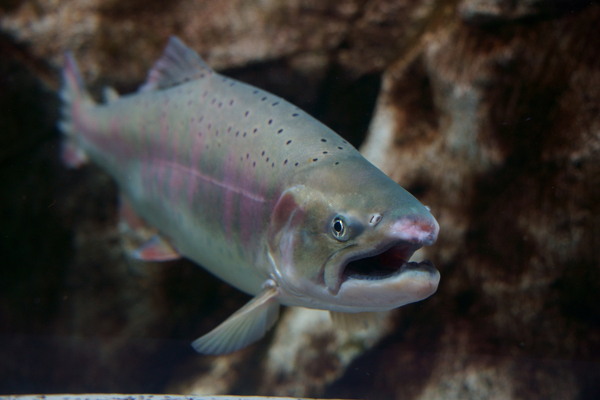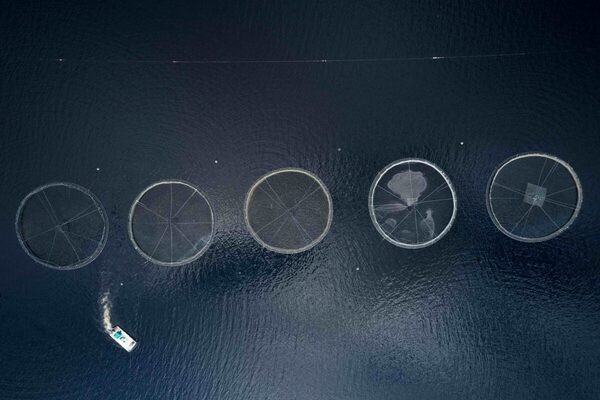Global business, local politics and uncharted territories
Benedikte Ranum reflects on a week of deals, debates and international discussions in Trondheim. Additional reporting by Robert Outram.
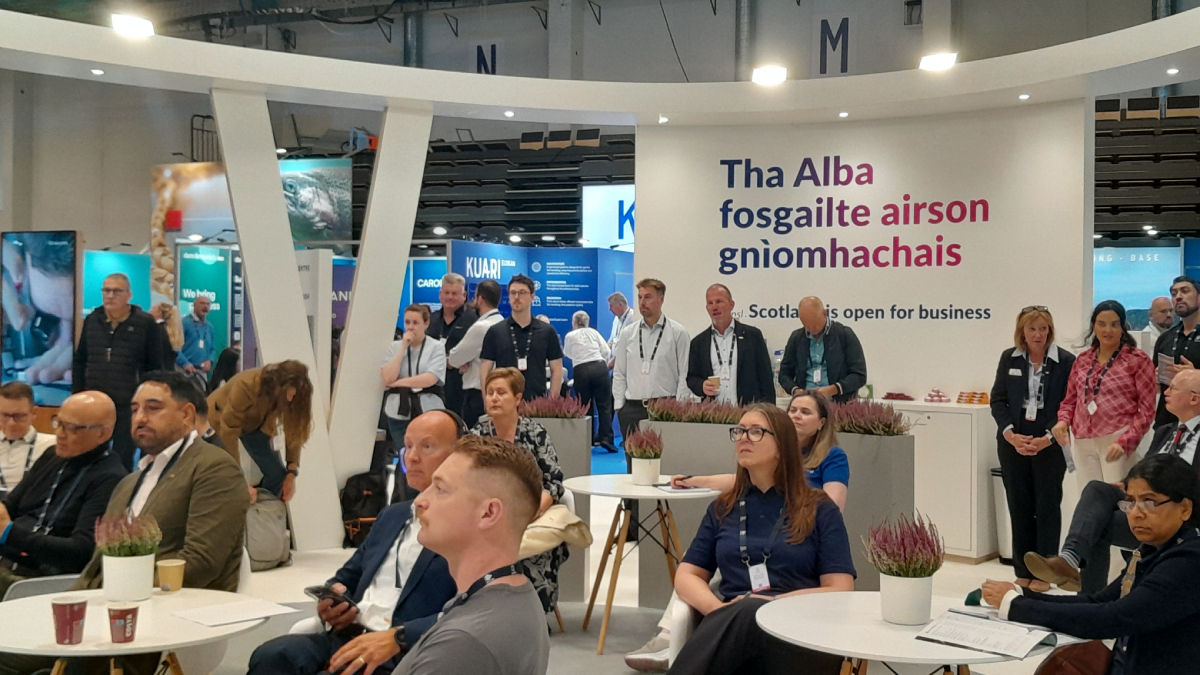
Another sell-out Aqua Nor event has taken place in Trondheim, Norway; this time with a tagline of going “beyond world-class technology”.
The trade show was dominated by three main topics: firstly, a global outlook, encouraged by the headline speakers at the pre-event conference as well as by the presence of 25,000 visitors and exhibitors from over 80 countries.
Secondly, a more inward-looking preoccupation: Norway’s general election on 8 September.
And finally, a greater emphasis than ever on non-traditional farming methods in new locations. Closed and semi-closed containment, submerged farming and even farming in tunnels were given unprecedented airtime and floor space this year.
A wider view: the pre-event conference
This year’s conference was hosted by Christine Spiten, sailor, engineer and tech entrepreneur. She outlined the bigger picture: 220m tonnes of marine plants and animals are harvested every year, of which 130m tonnes are farmed. A substantial percentage of this tonnage is seaweed; much of the production takes place in Asia; and the sector involves over 700 species. In other words, aquaculture encompasses a lot more than Norwegian salmon and high-tech solutions. We can expect an “industrial revolution” in aquaculture, Spiten predicted. But the sector should also focus on restoration and regeneration
As she put it: “Doing things with empathy as well as smartness.”
This global outlook was reinforced by keynote speaker Dr Sergio Nates, Senior Director for Aquaculture, World Wildlife Fund (WWF). He described the “trillion-dollar investment opportunity in sustainable aquaculture” identified in a recent report by the WWF and the World Bank. Their research indicates that global aquaculture has the potential to generate 22 million new jobs by 2050, accompanied by the prospect of $1.5 trillion (£1.1trn) of public and private investment.
“Aquaculture is too big to fail” said Dr Nates, while acknowledging that there are still misconceptions about the sector amongst potential investors. He added: “We need to teach the world about what we do.”
Hanging in the balance: the political debate
It is testament to the importance of salmon farming to the Norwegian economy that senior figures from all the main parties took time out during a fiercely contested election campaign to present their policies at Aqua Nor. The opening presentation, however, left no room for doubt about the context of the debate: sea lice and mortality figures.
For the first time, the Norwegian Veterinary Institute has released survival data for the first half of the year, rather than waiting for the full-year report. Ingunn Sommerset, the Institute’s Director of Fish Health and Welfare, shared statistics about 60-70 million “lost” fish over the last five years. While the January to June 2025 period show slightly lower mortality than the same period last year, Sommerset urged caution: a lot of fish have been placed in a new “other” reporting category, which is not included in the mortality figures just published. And after a summer of unseasonably warm waters, sea lice infestations are on the rise.
Line Ellingsen, owner of Ellingsen Seafood and Chair of Seafood Norway, represented the industry in the debate. At the top of the sector’s wish list from a new government, said Ellingsen, is market access, a close relationship with the EU and, above all, predictability – especially in the areas of taxation and regulation. She also said the industry would welcome a government directorate specifically for aquaculture, to provide a “macro-perspective” and reduce regulation complexity and delays.
The current Labour-led coalition government released “Havbruksmeldingen” – a report that sets out its intentions for the sector – earlier this year. During the debate, Marianne Sivertsen Næss, Minister of Fisheries and Ocean Policy, said the Government’s proposed new regulations should make it more profitable to operate with low environmental impact and good fish welfare. She said a suggested “loss fee” – where producers would be fined for high mortality rates – is still being explored.
Sivert Bjørnstad from the Progress Party, however, expressed doubt that such a fine would lead to improved welfare, rather than simply become another source of state income. His party wants to introduce other incentives for sector growth and sustainability, including eliminating the controversial ground rent tax, while centre-right Høyre wants to reduce it from 25% to 15%.
A sea lice quota was also debated, with agreement that a quota in itself was not sufficient: this might result in more frequent delousing activities, with subsequent mortality risks.
Despite the ideological differences, however, all the panellists were pleased with recent cross-party collaboration, citing the agreement that was reached between the six major parties to maintain the current regulatory system until a new framework has been established. It now remains to be seen whether the new government will be Labour or conservative-led, and how soon the Norwegian sector will have some certainty about the way ahead.
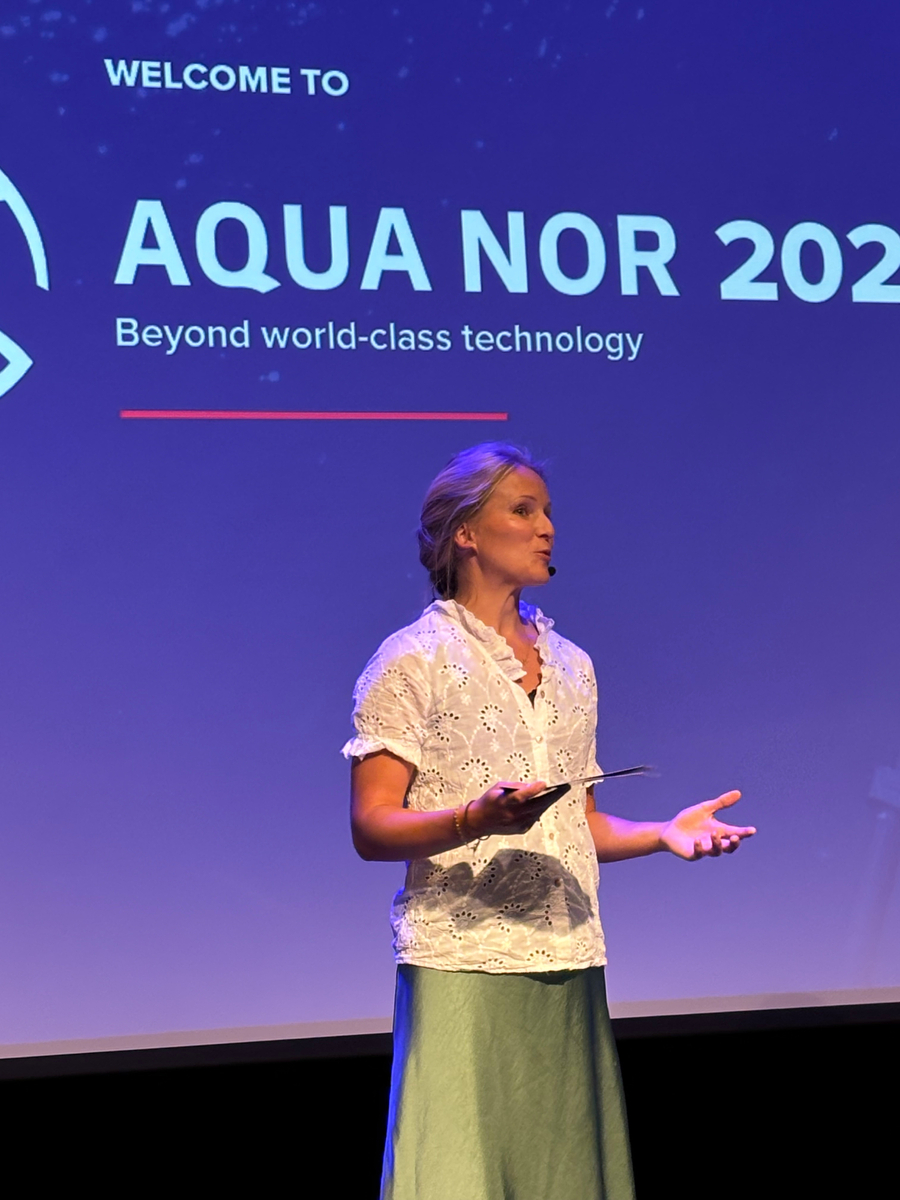
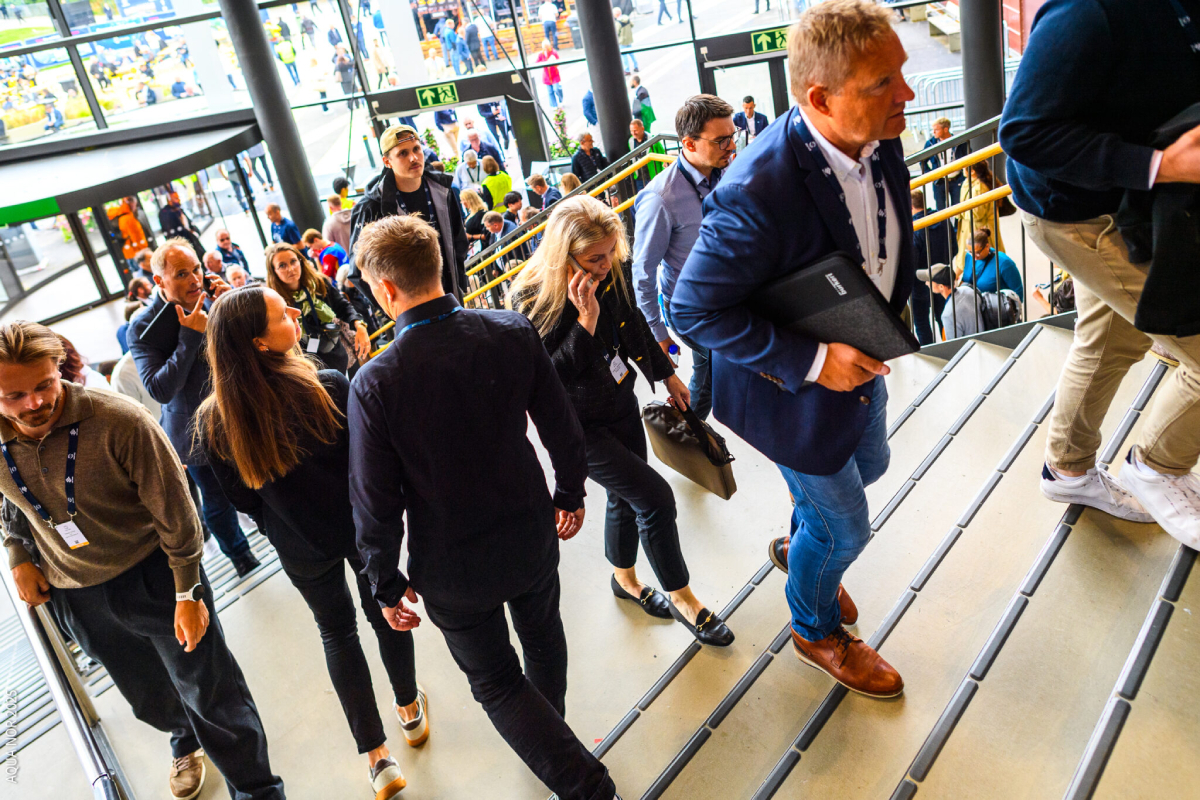
Biology lessons: closed containment
Non-traditional farming methods, and closed containment in particular, were a big focus at Aqua Nor 2025. At the pre-event conference, Sondre Eide of Eide Group – the creators of Watermoon – said they are really a biology company rather than a technology company.
And during the “Containing the Future” seminar, Tor Magne Madsen, CEO of Fishglobe, agreed: “Biology will eat technology for breakfast every day of the week.” In other words, if the fish are not healthy and happy, it doesn’t matter how groundbreaking the kit is.
Eivind Helland of the Stiim Aqua Cluster introduced their FLO SJØ network, focussing solely on floating contained systems at sea, and the BlueTalk and Blue Planet Academy knowledge exchange resources. The three companies represented in the seminar are competitors but also collaborate closely on shared challenges like construction and biology.
Cato Lyngøy of Ovum, originators of Egget, presented results including a tripling of fish weight within six weeks and an 0.83 feed conversion ratio. He also emphasised that to eliminate sea lice reproduction in the system is a key win, to stop the lice adapting and to remove the sea lice burden from the sector.
Access to the required licences and research facilities to thoroughly test the systems before they are populated was a recurring theme. Martin Søreide, CTO at ScaleAQ Seabased, said that Scale AQ had spent 50-60m NOK (~ £3.7m - £4.4m) with SINTEF on testing; it was a lot of money for the business, but Søreide said: “Unlike with oil and gas, you can’t just shut down biological production.”
Nils Johan Tufte of Bluegreen, whose Marine Donut is the world’s largest thermoplastic structure, said they were delighted to have been granted development licences for the Donut’s full-scale pilot. Once the livestock is in place, the panel agreed that any testing and tweaking of the systems should be performed with fish welfare in focus, as “fish like technology but prefer stability”.
Producers, represented by Lerøy’s Ellen Marie Kvamme during the pre-event conference, expressed the view that no one system is right for every location; that they use a rigorous list of criteria to assess which methods and technology will suit a particular site; and that a combination of traditional and cutting-edge solutions will form the future of farming.
Novel systems come with novel challenges, not least to do with regulations and licensing. Closed containment systems are expensive to build and buy, and the more systems there are – running with optimum biomass – the more cost-effective they will be. As Sondre Eide put it: “You don’t need to buy a Ferrari to drive in a 60 kilometre-per-hour zone.”
Now that the Scottish Government has given a long-awaited go-ahead for the nation’s first semi-closed containment farm (see UK News, in this issue) the Scottish sector’s eyes will also be on developments closer to home.
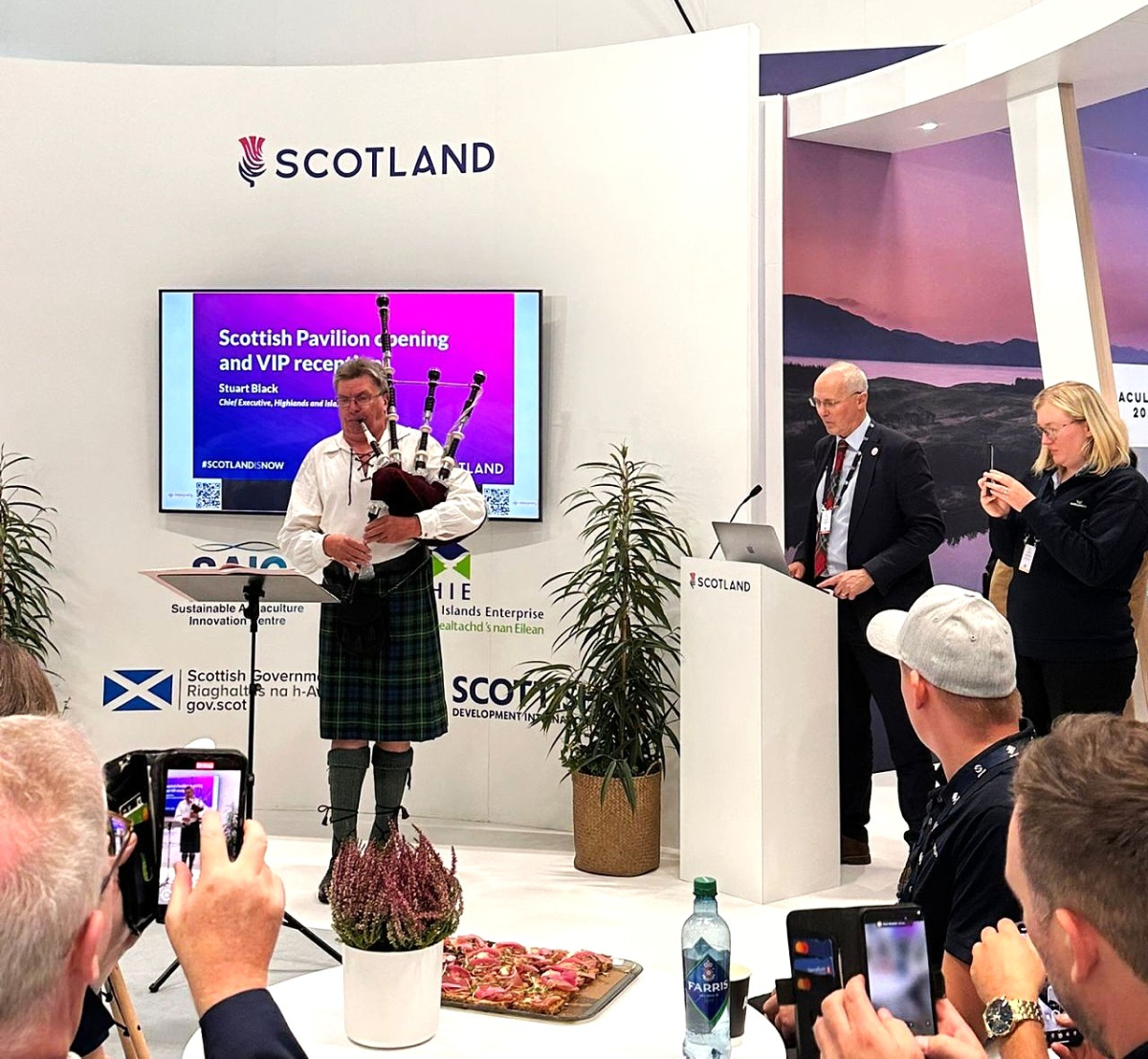
The return of the Scots
The Scottish Pavilion returned to Aqua Nor this year, again employing kilt-clad Norwegian piper Øyvind Luckow to draw attention to its official opening, introduced by Highlands and Islands Enterprise (HIE) Chief Executive Stuart Black.
A “Disrupting Innovation” panel discussion – chaired by SAIC’s Sarah Riddle and comprising panellists from business and academia – explored familiar but crucial topics that can help or hinder the sector’s future: climate change, R&D, social licence and emerging technologies.
The Pavilion also played host to an international panel discussion on aquaculture clusters, introduced by Cabinet Secretary Mairi Gougeon and chaired by Elaine Jamieson of HIE, with representatives from Norwegian cluster builders NCE Aquatech, Stiim, and Innovation Norway, as well as the Roslin Institute and SAIC.
The Scottish network organisations were keen to learn from the Norwegian clusters’ experience, with the latter having been operational for 15-20 years. Starting small (by finding a “non-threatening” shared challenge) and building trust over time, and by creating opportunities for cluster members to engage with each other in a non-competitive space, were two of the key takeaways.
A pertinent question that was left for panellists and audience members to mull over, was: “If Scotland had a national aquaculture cluster, what could we achieve that we are not already achieving?”
A chorus of young voices
Also on the Pavilion programme was an “International Young Voices” session featuring the Young Aquaculture Society from Scotland, Young Fish from Norway, a youth network from British Columbia and a young fish farmer from Tasmania. These organisations have recently joined forces to form the Next Generation Seafood Alliance, with Iceland and Chile also poised to come onboard.
While most of the networks shared two main value propositions – highlight career prospects for young people and attract young talent into the sector – the young Canadian farmers face a more critical challenge: their government’s ban on open-net finfish farming from 2029. This precarious situation has led to much uncertainty, not least among the two thirds of the workforce who are young people. The network has responded by using social media to present a positive and myth-busting view of the sector.
As the BC panellist Benjamin Del Curto said: “When your job is at risk, you can’t stay silent.”
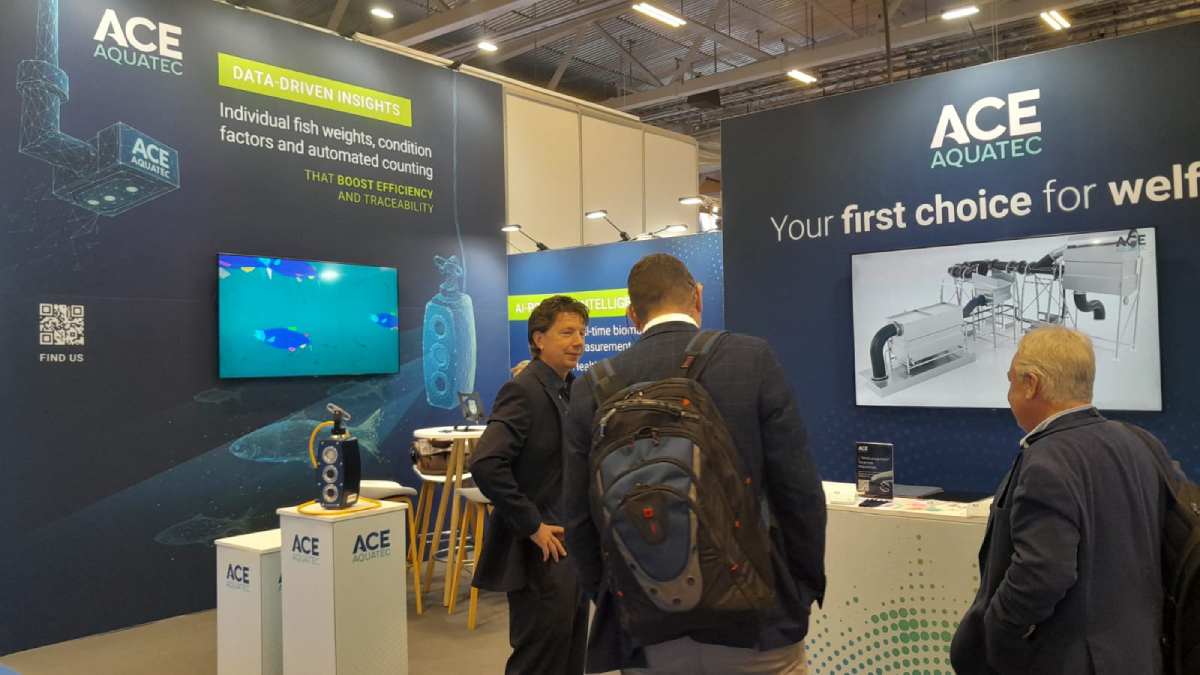
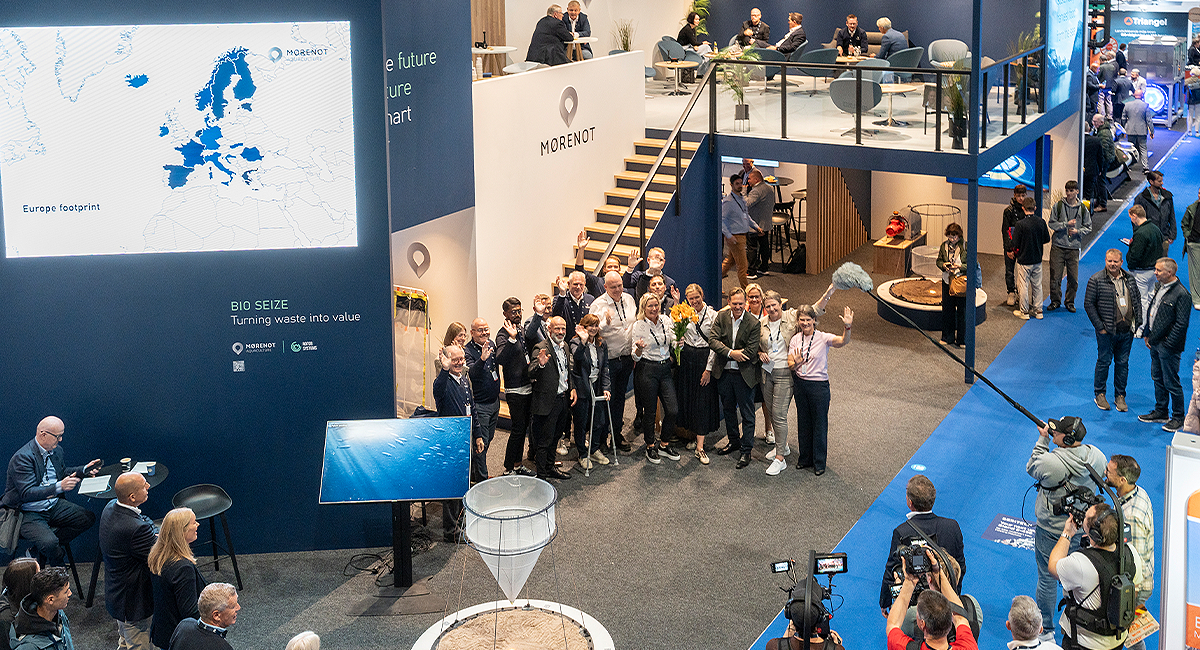
A word with the Cabinet Secretary
Mairi Gougeon, Cabinet Secretary for Rural Affairs, Land Reform and Islands, spent a hectic day at Aqua Nor but took the time to answer a few questions from Fish Farmer. She said: “It is really important for the Scottish Government both to have a visible presence here and to support the Pavilion itself. Scotland is the third biggest salmon producer in the world; we have so many businesses that are really at the forefront of the innovation we need to see to help the industry solve some of its challenges. For me, it’s about showing that the Scottish Government supports the work that these businesses are doing, and we are here to help them make the most of the opportunities at Aqua Nor.”
Commenting on the ongoing tariff uncertainties, Mairi Gougeon said “We do know that the volatility around these matters is a big challenge for the industry. Although the tariff that’s in place is slightly better than for some other countries, we want to do what we can to make sure the rate is as preferential as possible and that we retain access to these important markets. We want to work with the industry to navigate this issue.”
On a positive note, she noted the strength and growth of the recent export figures for Scottish salmon. “It’s great to see the quality and provenance of Scottish salmon recognised. We want to see that success continue to grow, and that’s why there is so much work underway at the moment in relation to aquaculture.”
Finally, the Cabinet Secretary was anticipating a meeting with the youth organisations: “As I go around and speak to the different businesses, I see that there is so much innovation, so much investment, and I think the career opportunities are immense – the sky really is the limit. So, I’m really looking forward to hearing the young people’s ambitions for the future. And it’s important to see that in the context of the Scottish Government’s vision for sustainable aquaculture to 2045; I hope that vision gives young people confidence of where we are planning to go in terms of the growth of the sector.”
Sealing the deal
The event organisers have just signed a letter of intent with Trondheim municipality for Aqua Nor and Nor-Fishing to remain in the city for a further 10 years. Kristian Dahlberg Hauge, Leader of the City Council and Governing Mayor of Trondheim, commented: “The presence that Nor-Fishing and Aqua Nor have in Trondheim has major ripple effects for the business community, and the value of having the fairs here is between NOK 2-3bn [£150m-£222m] over ten years.”
This is a coup for Trondheim; as we have seen in Scotland with Aquaculture UK’s move from Aviemore to Glasgow, a large-scale trade event can outgrow its location and go elsewhere. One thing is certain, though: despite predictions that in-person industry events will soon be dead in the water, aquaculture professionals still prefer to meet and do business face to face.
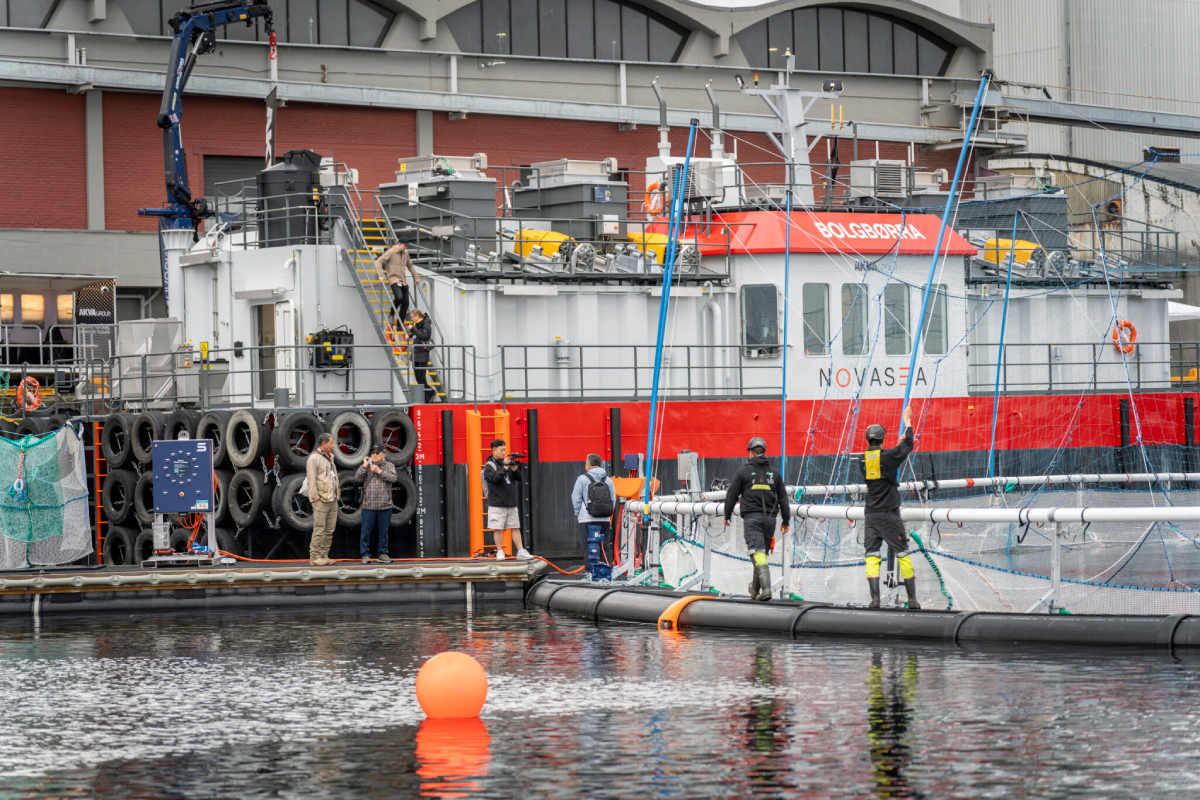
Deals and launches
As ever, Aqua Nor was the occasion for deal announcements and product launches.
MSD Animal Health announced the launch of a new generation of FALCON® vision technology. The new generation integrates cutting-edge vision technology and AI to provide near real-time insights into the prevalence of sea lice and wounds in fish populations, while at the same time monitoring biomass development.
Dafydd Morris, General Manager of MSD Animal Health Aqua EURAM, said: “Early detection of fish lice and the data produced by the system means it has the potential to identify lice sooner than traditional sampling methods, allowing for earlier intervention. This approach helps in selecting the most effective treatment products for each lice life stage and assessing treatment effectiveness for continuous improvement. Additionally, monitoring wound prevalence, size, severity and healing status trends enables enhanced health and welfare management for fish populations.”
CFEED, the world’s leading producer of live hatchable Acartia tonsa copepod eggs for marine aquaculture officially opened its expanded production facility in Vanvikan, near Trondheim, while Aqua Nor was underway,
The expanded facility represents a significant milestone in marine aquaculture, the company said, with production capacity more than tripling to meet rapidly growing global demand for copepods as live starter feed.
Damen Shipyards Group and Folla Maritime officially launched their new joint venture shipyard under the name Damen Folla. This new identity, they said in a joint statement, marks the next step in a partnership focused on delivering high-quality and sustainable vessel solutions for the aquaculture sector (see Boats and Barges feature, starting page 56).
Scottish-based technology company Ace Aquatec rolled out several significant developments ahead of the show across its AI technology suite. The company has successfully brought five species specific modules and new health and harvest monitoring tools for its groundbreaking A-BIOMASS® AI powered underwater camera to market since launch. These specially trained modules have been designed for use with Atlantic salmon, trout, yellowtail, chinook salmon and char.
The AI camera identifies and records welfare indicators, providing a range of information on fish conditions and externally observable health status such as wounds and maturation. The company also said its proprietary A-HARVESTCAM® module has been deployed at harvesting sites in Scotland. This innovation allows real time average weight, distribution of fish count and weight classes measurements at harvest.
Also at Aqua Nor, Moleaer announced the global launch of Freya, its first fully submersible nanobubble system for aquaculture. The company said trials in Chile and Norway showed the system offers up to 40% lower oxygenation operating costs and up to 60% lower oxygen-related energy use.
Benedikte Ranum is a communications and marketing professional, and former Knowledge Exchange Manager with SAIC, the Sustainable Aquaculture Innovation Centre.
Why not try these links to see what our Fish Farmer AI can tell you.
(Please note this is an experimental service)
